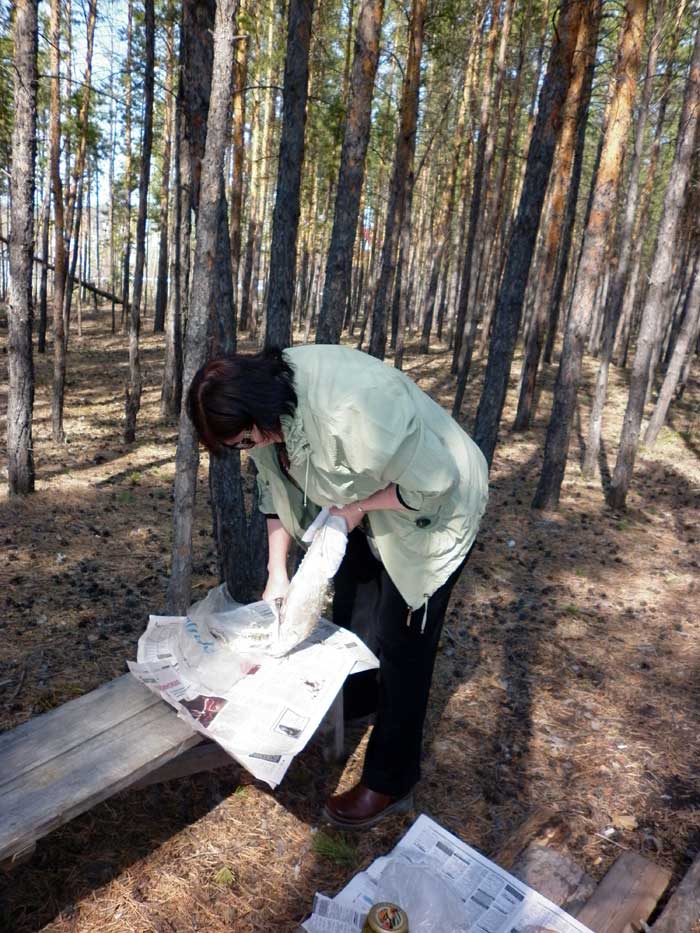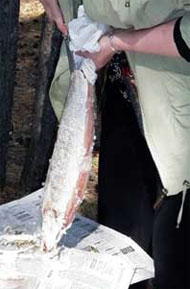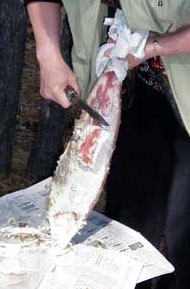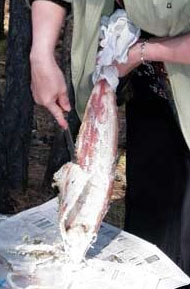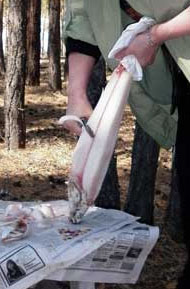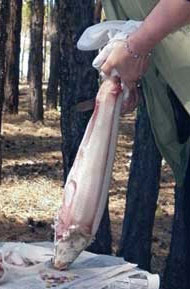YUKAGHIR NATIONAL CUISINE
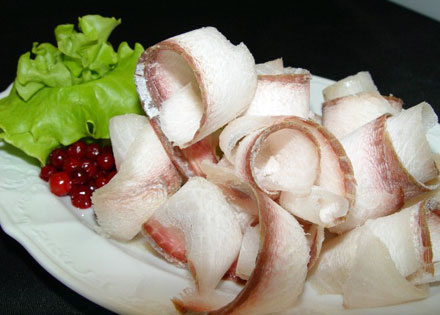
Пища юкагиров
Teliedalgza Yukola
Prepared from large fish of good quality. Clean fresh fish from scales, gut. Separate the meat from the ridge and cut off the backbone to the tail. Cut the fillet into 4 plates without touching the skin, make cuts on the inside in the form of a cage or herringbone. Dry on a hanger first in a sunny place. When dry, but not hard, remove from the hanger and hang over the hearth in the yaranga. Here the yukola is brought to full smoking.Egale
After slaughter, a large piece of meat with lard is cut out of the fresh carcass of the deer. The meat is cut into flat oblong layers, evenly distributing the fat. Layers from one end are strung on tendon threads and hung on a blown sunny place to dry. The dried meat is stored in bags and consumed in the winter.Kulibakha
Fresh fish is cleaned of scales, the entrails are removed, then freed from the bones. The pulp is pounded and mixed with peeled and crushed blueberries, and fish oil is added here. Serve as a separate meal.Ehalang – meat roe-corns
In summer and autumn, reindeer meat was prepared for the winter. Pieces of venison were cut into oblong layers, strung on tendon threads and hung in a blown sunny place. Sufficiently dried meat was finely crushed, then they were poured into a bag. The eggs were stored in a yaranga, in a cool dry place. Before eating, minced meat was mixed with finely chopped pieces of reindeer intestinal fat and fried. If there was no deer oil, it was replaced with fish oil. Served as an independent dish.Chumudodye - smoked meat
The broad vertebral tendon is cut lengthwise into pieces; the meat is carefully separated from the tendon, then cut into flat layers and dried in the sun. The meat that has not yet hardened is kept on the smoke of a hearth in a yaranga. The crushed deer bones are boiled in a cauldron for a long time, periodically remove the floating fat, and cool. The smoked meat is cut into small pieces and served along with the cooled fat. Such meat can be boiled in water. Salt and spices are added during cooking.Porsa
The fish was dried in the air, but so that it did not dry out. Then they were freed from the bones, the meat was cut into small pieces and fried in fish oil. After that, they were placed in a bag or barrel. Such a product was convenient for a hike, so the hunters took it with them on a long trip.Anil carile
The cleaned fish is boiled until tender. The broth is poured in, and the fish is dried in the sun, spread out on a special floor. After drying, it is pounded into the finest mass or flour. Fish meal is stored in burbot skin bags. Consumed in winter. To do this, boil it in water, add deer blood, mix and bring to readiness. Salt to taste.Fish giblets dish
The cleaned, washed giblets of large fish are boiled, the broth is drained. The giblets are mixed with rose hips and poured with fish oil. This mixture is filled with birch bark and frozen. They eat in winter.Fish belly dish
Peeled fish, usually omul, is cut, the abdomens are cut out, and a separate dish is prepared from it. Having peeled them well, they are fried in a pan in fat, then dried on a tray and pounded. Mix with berries, crushed caviar and fish oil. It is very nutritious and delicious.Yukagir-style flatbread
Fresh fish is cleaned of scales and fins, the head and tail are cut off, gutted, washed in cold water and boiled. After that, carefully freed from the bones, cut into very small pieces. Fresh caviar is cleaned of films, pounded, combined with pieces of fish, salt to taste, mixed well. Add flour, knead the tough dough and roll out a round tortilla, place in a greased frying pan and bake. Before use, the flat cake is cut or broken into slices, served with melted deer fat or butter.Caviar drink
Fresh boletus caviar is thoroughly pounded to a liquid state, salt is added, mixed, then cooled. Poured into cups and served as a soft drink. This very healthy and tasty dish has been prepared since ancient times.[1] Основной пищей были мясо и рыба. Оленье мясо ели сырым и вареным, зимой — строганину, весной и летом коптили над костром и вялили на солнце длинные тонкие пласты мяса. Сушеное мясо (эхалэнг), нанизанное на жильные нитки, хранили в мешках в амбарах и варили зимой. Из трубчатых костей вываривали жир. Из взбитой свежей оленьей крови готовили суп (хаша). Питались также дичью: таежные — мясом зайцев и куропаток, тундровые осенью и летом — мясом уток и гусей. Гусиные и лебяжьи желудки ели сырыми. Рыбу варили, вялили, квасили в ямах, хранили в слое вечной мерзлоты, делали строганину (чахаа), юколу (уйкэлэ), толкли в порошок-порсу (баргу). Брюшки, налимью печень употребляли сырыми, потроха и икру жарили. Из икры с рыбой пекли лепешки. Летом готовили рыбу, заворачивая ее на сутки в листья тальника. Лакомством считались толченая вареная рыба с голубикой и жиром (кульибаха), рыбная мука, сваренная с оленьей кровью или сосновой заболонью (анил кэрилэ). Пили чай, заваривали шиповник, чагу. Ягоды, рыбу хранили в берестяных туесах (оччо). Корзины плели из тальника. Посудой служили деревянные и берестяные сосуды четырехугольной и круглой формы. Для хранения порсы, вяленой рыбы и мяса шили ровдужные или тканые мешки, для женского рукоделия — сумки из лапок птиц или ровдуги.A workshop on the preparation of stroganina is conducted by L.N. Demina
- Photographs by L.N. Zhukova
Yukaghir gastronomy

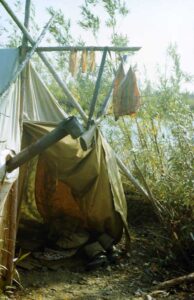
Omul and chir, which, as Argentov wrote, "perfectly white and deliciously tasty caviar", were among the "best native fish." But muksun was one of the best. Argentov also called the white fish a fish of "high dignity", in Nizhnekolymsk "nezna-khu”; it made "the most excellent stroganina." Pelyad was also famous as “excellent tasty fish”. In sterlet, which the Yukaghirs caught in winter with hair nets, caviar was especially valued, and its meat was preferred to sturgeon meat.
We did not say anything about the herring, and yet it deserves special attention. In different regions of Eastern Siberia, it is called differently: kondevka, vendace, herring ... Until now, it is the decoration of the festive table on the Yenisei, Lena, and Kolyma. This little fatty fish is delicious and abundant. “There are about 2,000 parishioners in the Nizhnekolymsk parish,” wrote Argentov, “and all these people, with a few exceptions, are fed and, one might say, live on herring.” Sled dogs were also alive with herring, the number of which was one and a half times the number of parishioners. That is why the locals said about the herring: "This is our manna ..."
Fish was consumed in different forms: it was boiled, fried, baked, fermented, dried, smoked and frozen. According to Argentov, the people of Kolyma even cooked "bread, pies, pancakes" from fish. Among the Yukaghir fish dishes, he calls: “belly, cast, sliced, roe, roe, boiling, drums, turner, borchu, body, body, mess, pounding, humps and feathers, intestine, baked tail, navels, dumplings, boiling water , yukolnitsa, yukola, khakhty, khachira, bone. " Individual dishes can be judged by these names (tolkusha, dumplings), but some are just a mystery. What is, for example, a kavardak?
In the list we find several clearly Tungusic ones: “tela” (correctly “tala”) - raw fish; "Corporeal" - (apparently the same); “Yukola” and “yukolnipa” (from the Evenk “nyak”) - “dried fish”. The Yukaghirs usually ate "white" fish (nelma, chir, omul, etc.) raw, without any spices. But the "black" lake (pike, perch, burbot, etc.) was cooked, apparently, because of its infestation with helminths.
Для изготовления юколы юкагиры срезали с самых крупных и жирных рыб кожу со слоем мяса толщиной примерно в два сантиметра. Куски вешали для просушки на воздухе либо в коптильне. Хребет с остатками мяса сушили отдельно. Без ущерба для качества юкола может храниться в течение года.Продуктом более длительного хранения являлась барча, или порса*. Чтобы получить барчу, частично провяленную на воздухе рыбу освобождали от костей, разрезали на мелкие части и варили с рыбьим жиром. Полученный продукт укладывали в бочонки или мешки. Как считал Г. Л. Майдель, барча (у него порса) представля¬ла собой «сравнительно удобную форму консерва»; ее охотно брали в путешествие. Соление рыбы до конца прошлого века было практически неизвестно населению Северо-Востока, не исключая и русских старожилов. Указывая на то, что вяленая рыба нередко получалась недоброкачественной из-за сырой погоды, Майдель резко порицал «до невероятности ленивых и беспечных людей», отказывавшихся солить рыбу. Дело тут, однако, заключалось не в лени, а в непривычке к соли. Тем более что и соленую рыбу трудно сохранять больше года. Пожалуй, единственным способом сохранения питательных свойств рыбы на более длительный срок является ее замораживание. Майдель лично попробовал нельму, которая в замороженном виде пролежала в погребе три года, и ни он, ни его спутники не смогли отличить ее по вкусу от только что пойманной. Речь шла о свежезамороженной рыбе, сохраненной в оболочке из льда. Такая оболочка образуется, если выловленную зимой рыбу дважды обмакивают в воду и тут же на воздухе замораживают. Юкагиры такого способа хранения рыбы не знали. К тому же главный лов рыбы приходился на осень, во время ее нерестового хода, когда заморозить рыбу было нельзя.
Fish caught in summer were dried by the Yukaghirs, just like Russian old-timers, and the autumn fish, in most cases, were kept in pits dug in the permafrost. In one business note, which I found in the archives of the Allaikhovsky district Executive Committee, a certain worker who visited the lower Indigirka in the 1920s wrote that local residents "usually use rotten, spoiled fish products", as they "ferment" fish. The author of the note believed that this had a harmful effect on people's health, and suggested that “appropriate measures” be carried out - which, however, he did not indicate.
For the sake of objectivity, it should be noted that the centuries-old consumption of "pickled" fish has not revealed any negative consequences for human health. And as you know, there is no dispute about tastes. A bear, for example, also prefers that the fish caught by him "sour" a little.
Women and children were engaged in harvesting plant products from the Yukaghirs. They usually collected the roots of thyme and other edible plants, which they ate raw, added to the stew, in pies with fish and meat, and also served separately "instead of dessert, before tea." Thyme was used not only for food, but also instead of tobacco. Pancakes - "drums" were baked from fresh sedge roots, washed in warm water and crushed together with fresh herring caviar.
Edible roots - pelkhi - were often borrowed by Yukaghirs and Russian long-time residents from the reserves of field mice. “In October, women walk through the forests, look where there are many mouse holes: here they cut the ground and find roots in heaps in the so-called mouse barns,” wrote A. Ye. Dyachkov. F. P. Wrangel noted that "women have a special gift to seek such shelters and take away from poor animals the fruits of their prudent care."
Pelkhi

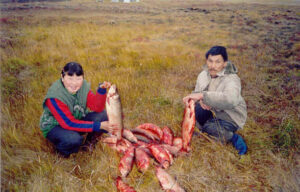 Summer catch
Summer catchАнадырские шаманы прибегали к мухомору как к допингу. Шаман, которого просили полечить или «разгадать какое-нибудь тайное дело», требовал, чтобы его угостили мухомором — «будто бы от того прибавляется сила шаманства». При отсутствии чая верхнеколымские юкагиры кипятили березовую или осиновую «шишку» (чага) с какими-то «черными грибами» и стеблем шиповника.«Мухоморный пьяница после пьянства как бы с того света пришел; говорят, будто мухомор показывает ему рай и ад…» «…для мухоморного пьяницы не нужно для разговора посторонних лиц, потому что он сам по себе один разговаривает, или со своими мухоморами, или передразнивает посторонние слова».
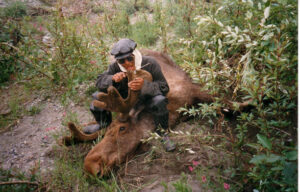
References:
- В.Н. Федорова. “Блюда народов Якутии” – Якутск: Кн. изд-во, 1990. – 208 с.,ил.
- Encyclopedia "The Arctic is my home: the peoples of the North", Moscow, 2001.
- Туголуков В.А. Кто вы, юкагиры? – М.: Наука, 1979. – 152 с., ил.




